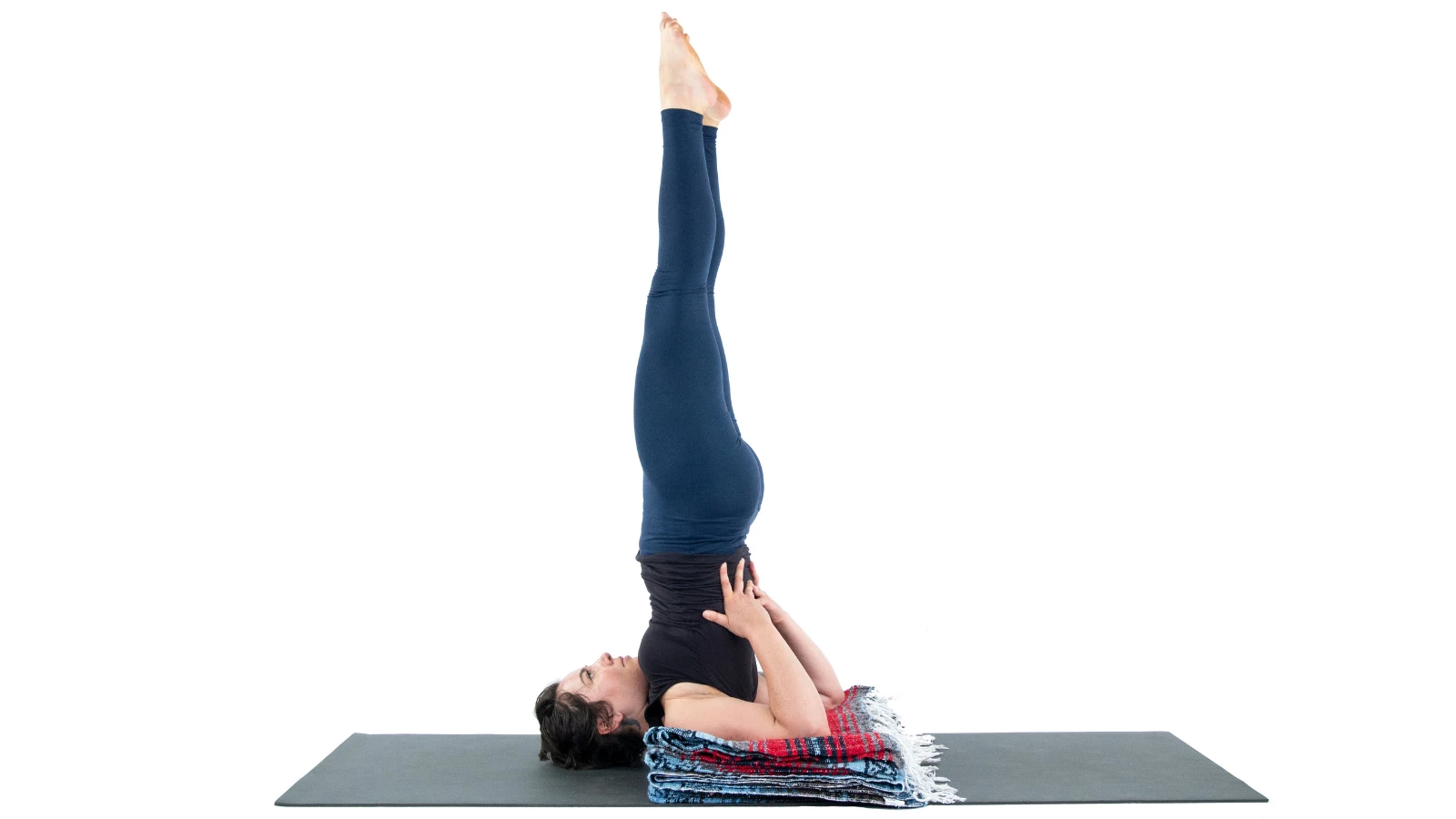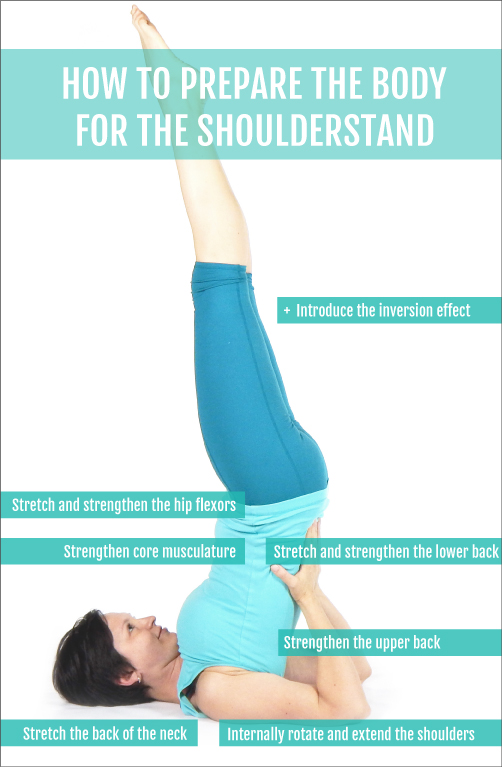5-Step Yoga Sequencing for Shoulderstand

Article At A Glance
Shoulderstand (Sarvangasana) is known as the “Queen of Yoga Asanas”, but despite (or because of!) this title, it’s an incredibly challenging posture. The thoughtful sequencing methodology presented in this article can help us maximize the benefits of this pose while keeping the neck safe.
Leslie Kaminoff makes an excellent point when he speaks about yoga sequencing for Shoulderstand Pose (Sarvangasana): it is not the same as choreography. In choreography, the goal is artistic expression; choices are dictated by elegance and aesthetic appeal. Of course, it’s nice when a yoga class flows gracefully, but that is not the primary goal.
We do not practice yoga to look pretty while we practice. We practice getting some benefit, whether physical, physiological, or psycho-emotional. We arrange poses and other elements in a yoga practice by what we want to accomplish and how we can get there effectively with minimum risk to the body.
Let’s use the Shoulderstand Pose to illustrate the class planning process for maximum benefit and minimum risk. We’ll call it a five-step sequence planner. This process can be applied to any other posture.
5-Step Yoga Sequencing for Shoulderstand
Step 1: Shoulderstand Pose Analysis for Sequencing
A shoulderstand is a risky posture because your neck is placed in a vulnerable position. It can strain the muscles, ligaments, and nerves of the neck. To minimize the risk for your neck, you might choose to place a blanket under the upper back, as in Supported Shoulderstand Pose (Salamba Sarvangasana). Or you could shift the weight from the neck more toward the upper back, as in Legs-Up-the-Wall Pose (Viparita Karani).
Whichever option you choose, it’s not safe to start with it or put it at the very end of the practice. To do Shoulderstand safely, you need to have strong upper back and lower back muscles and core musculature. The traditional presentation of a yoga practice involving inversions (outlined by Sri Krishnamacharya) looks like a bell curve with a Shoulderstand at the top. Our yoga sequencing should include poses to prepare the neck and upper back for the load that they are about to bear and to compensate for it.
Step 2: Shoulderstand Preparation
 It might take some time to develop the strength of the upper back, lower back, and core musculature. This does not happen within a space of one class. We call it “long-term preparation.” It involves using other, less risky poses to strengthen the target areas.
It might take some time to develop the strength of the upper back, lower back, and core musculature. This does not happen within a space of one class. We call it “long-term preparation.” It involves using other, less risky poses to strengthen the target areas.
“Short-term preparation” describes the choices you make within the space of one class leading up to the Shoulderstand. The minimum preparation that we have to do before attempting this pose includes:
- Forward bends to stretch the lower back
- Twists and/or lateral bends to warm up the neck, shoulders, and upper back
- Some “legs up” pose to introduce the inversion effect
- Bridge Pose (Setu Bandhasana) to stretch the upper back and neck right before the Shoulderstand
Contrary to popular belief, Plow Pose (Halasana) is not good preparation for Shoulderstand because it puts the neck and spinal extensors into a more strenuous position.
Step 3: Shoulderstand Assessment
It is essential to include poses that will demonstrate whether or not the student is ready to do Shoulderstand on that particular day. We use Half Standing Forward Bend Pose (Ardha Uttanasana) and Locust Pose (Salabhasana) to assess the neck, upper, and lower back strength. The student should be able to hold each of them in good form for at least three breaths. If it’s not possible, Shoulderstand is not recommended.
Step 4: Compensation
Compensation means taking steps in your yoga sequencing to help the body return back to a neutral state. If you bend deeply one way, it’s essential to bend the other way afterward to balance it out. A common compensation pose for Shoulderstand is Fish Pose (Matsyasana), but it isn’t the best choice.
Yes, Fish Pose places the neck and upper back in the opposite position from the Shoulderstand. The problem is that you lock your upper body in place, and the muscles at the back of the neck stay passive. A better option is to move the body in the opposite direction (instead of locking it there) to restore the contractile power of the intensely stretched muscles in Shoulderstand.
In other words, we need to actively engage posterior neck muscles and upper back to increase blood flow to the area and do it in a way that is not as stressful and passive as Fish Pose. Cobra Pose (Bhujangasana) is an excellent choice. But Cobra Pose is not enough. We also need to mobilize the arms locked in Shoulderstand with some arm-sweeping motion and rebalance the relationship between the neck, shoulders, and upper back with some simple twist.
Step 5: Reevaluation in Yoga Sequencing
Once we look at the poses we’ve selected so far, we will notice that we need to include some other compensatory poses to neutralize the effect of the more challenging postures. For example, we usually put some sort of a forward bend after a deep backbend or a twist. In addition, we might need a bit more warming up before we attempt poses like Ardha Uttansana. We will also include Relaxation Pose (Savasana) at the end to rest and integrate.
And there you have it. This is a basic outline of the yoga sequencing practice for Shoulderstand. In the sequence, we consider adequate preparation, compensation, and no random elements. Theoretically, this kind of thinking should go into the design of every yoga practice. Of course, despite all those elements in place, Shoulderstand is still not safe for everyone. Some contraindications include disc problems, high blood pressure, glaucoma, sinus blockage, obesity, and general upper back/shoulders/neck weakness.
Yoga Shouderstand Practice: the Video
*If you choose to teach and practice Shoulderstand, please be mindful of those risks and take care of yourself and your students!
Also, read...
Are Headstands Bad For You? Everything You Need to Know About Neck Safety
3 Ways to Counteract Text Neck with Yoga
5-Minute Yoga Challenge: How to Practice Half a Headstand
Related courses
Breath as Medicine: Yogic Breathing for Vital Aging
Yoga and Myofascial Release: Releasing Chronic Tension with the Bodymind Ballwork Method
Yoga and Detoxification: Tips for Stimulating Lymphatic Health

Educated as a school teacher, Olga Kabel has been teaching yoga for over 14 years. She completed multiple Yoga Teacher Training Programs but discovered the strongest connection to the Krishnamacharya/ T.K.V. Desikachar lineage. She had studied with Gary Kraftsow and American Viniyoga Institute (2004-2006) and received her Viniyoga Teacher diploma in July 2006, becoming an AVI-certified Yoga Therapist in April 2011. Olga is a founder and managing director of Sequence Wiz— a web-based yoga sequence builder that assists yoga teachers and yoga therapists in creating and organizing yoga practices. It also features simple, informational articles on how to sequence yoga practices for maximum effectiveness. Olga strongly believes in the healing power of this ancient discipline on every level: physical, psychological, and spiritual. She strives to make yoga practices accessible to students of any age, physical ability, and medical history, specializing in helping her students relieve muscle aches and pains, manage stress and anxiety, and develop mental focus.



